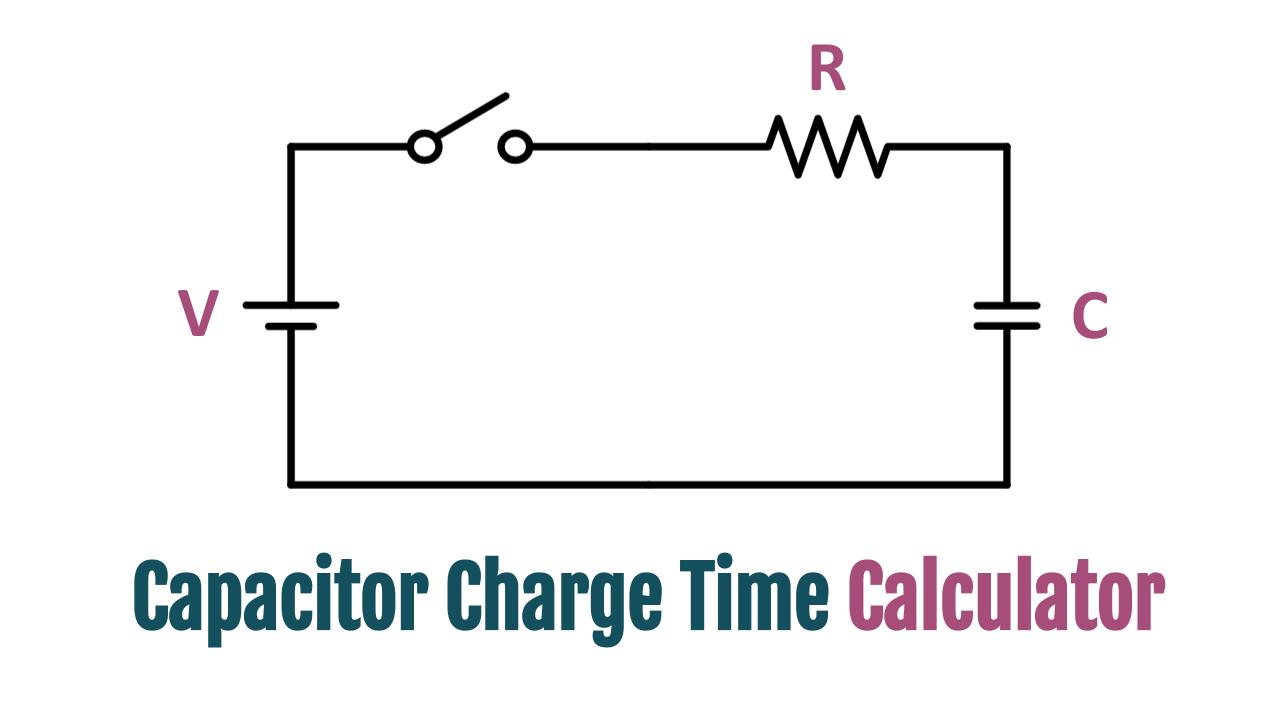Calculate the time it takes to charge a capacitor to the level of the input voltage.
Calculator
Enter the values of
- Resistance – use the drop down menu to select appropriate units mΩ, Ω, kΩ or MΩ.
- Capacitance – use the drop down menu to select appropriate units F, mF, μF, nF or pF.
- Number of time constants – the default value is 5. However, any numerical value can be entered recognizing that a number less than 5 means the capacitor will not be fully charged.
Formula
Vc = Vi (1-e-t/τ)
where,
- Vi = Input Voltage
- τ = time constant
- Vc = voltage at the capacitor at time t
Time constant τ = RC, where R is resistance and C is capacitance.
At t = 5*RC = 5τ (or 5 time constants),
Vc/Vi = (1-e-5) = 0.9933
In other words, at t = 5τ, the capacitor voltage reaches 99.33% of the input voltage.
Table of Time Constant vs Charge
The table below shows multiple time constant vs. % charge.
| Number of Time Constants | % charge |
|---|---|
| 0.5 | 39.3469340287 |
| 1 | 63.2120558829 |
| 2 | 86.4664716763 |
| 3 | 95.0212931632 |
| 4 | 98.1684361111 |
| 5 | 99.3262053001 |
| 6 | 99.7521247823 |
| 7 | 99.9088118034 |
| 8 | 99.9664537372 |
| 9 | 99.9876590196 |
| 10 | 99.9954600070 |
Example Calculation
For R = 1 kΩ and C = 1 nF, the capacitor charging time is 5 µs.
Background
What is a Capacitor?
A capacitor is an electronic component that stores electric energy. It is made up of two conductive plates separated by a non-conductive dielectric material. The picture below shows an Aluminum Electrolytic Capacitor.

A key attribute of a capacitor is its ability to store charge in the form of an electric field. When a voltage is applied across the plates, an electric field is created due to an accumulation of charges on the plates. The charge storage capability of a capacitor is measured in a unit called capacitance, which is measured in farads (F).
The higher the capacitance value, the more charge the capacitor can store.
What is Charge time of a capacitor?
As the term suggests, it is the amount of time it takes for the capacitor to reach a desired voltage level. In the calculator above, the default value of five time constants or 99.33% is used.
In other words, we compute the time that it takes to charge the capacitor to 99.33% of the input voltage.
As the resistance R or capacitance values increase, so also does the time it takes to reach this value.
Capacitor Applications
Capacitors play a crucial role in electronic circuits as they can store and release electrical energy quickly. They are used to smooth out power supply ripple, block direct current (DC) while allowing alternating current (AC) to pass through, and also for storing and releasing energy in timing circuits. Capacitors come in various sizes and types, ranging from small surface-mount capacitors used in modern electronics to large electrolytic capacitors used in power electronic applications.
The charge time plays an important role in the sample-and-hold circuit of an ADC.
Why do we use 5 time constants?
To understand why we use 5 time constants and not 2 or 10 for instance let’s take a look at the table below
| Time Constant | % Charge | % Difference |
|---|---|---|
| 0.5 | 39.3469340287 | |
| 1 | 63.2120558829 | 60.6530659712634 |
| 2 | 86.4664716763 | 36.7879441171442 |
| 3 | 95.0212931632 | 9.89380198014472 |
| 4 | 98.1684361111 | 3.31203969462643 |
| 5 | 99.3262053001 | 1.17937010594147 |
| 6 | 99.7521247823 | 0.42880877302731 |
| 7 | 99.9088118034 | 0.157076374516417 |
| 8 | 99.9664537372 | 0.0576945443797278 |
| 9 | 99.9876590196 | 0.0212123983484808 |
| 10 | 99.9954600070 | 0.00780195026957234 |
In the second column, the table shows the % charge achieved depending on the value of the multiple of time constant (TC) in column 1.
For instance at TC = 2, t = 2τ and the voltage at the capacitor is 86.47% of the input value.
The third column shows the % increment relative to the previous TC.
We can see that going from TC=0.5 to TC=1, the difference is over 60%. This difference decreases with an increase in TC.
At 5 it’s only 1.18% whereas any value of TC greater than 5, it’s less than 1%. In fact at 10 it’s only 0.008%. At these values, we can say that the capacitor is fully charged. The value of 5 is chosen to be the threshold in most computations.
Since it’s an exponential function, the % charge will never reach exactly 100%. Instead it will get closer and closer to this value.
Related Calculators
- Capacitor Discharge Time – How long does it take for a cap to discharge from an initial to a final voltage level?
